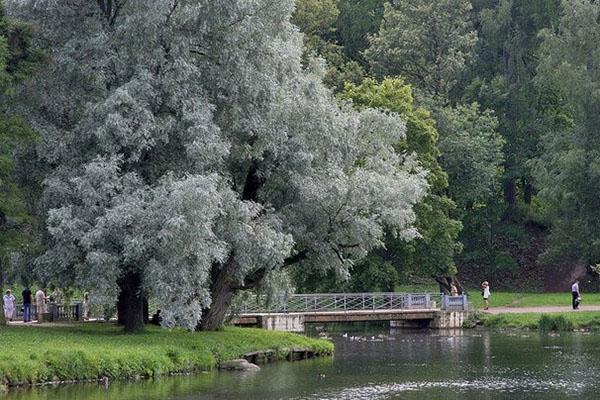Types of weeping willow, their features and rules for caring for the plant
 Weeping willow is a large tree that can often be found near rivers and water bodies in temperate climates. Judging by the fact that the plant feels great in the wild and tolerates heat and frost, it will not be difficult to care for it at home. Willow looks great in parks, recreation areas or even in the yard.
Weeping willow is a large tree that can often be found near rivers and water bodies in temperate climates. Judging by the fact that the plant feels great in the wild and tolerates heat and frost, it will not be difficult to care for it at home. Willow looks great in parks, recreation areas or even in the yard.
The tree can grow up to 25 meters and live 100 years.
What are the varieties of willow?

- White willow is a tree whose height can reach 25 m. The lifespan of the variety is about 100 years. White willow is called because the leaves are light colored on the underside. The plant thrives on the banks of rivers and water bodies, it can also be planted near an artificial pond.
- The weeping white willow also has an unusual color, but differs in the shape of the crown. Its branches are long, flexible, drooping to the ground. The bark of the tree has a rich yellow hue.
- The Babylonian willow also has a weeping crown. In height, it can reach 15 m or more, the life span is about 100 years. The leaves are light, but without a silvery shade. The tree grows rapidly and reaches its peak. The most comfortable conditions for his life are the well-lit shores of reservoirs.
- The shaggy dwarf willow is a shrub that does not grow taller than 2 meters. Her leaves are different from those that grow on the usual weeping willow - rounded and covered with light fluff. This plant can form a crown of an unusual shape, since the shoots are strong and grow upward. The shrub easily tolerates winter frosts, prefers to grow in moist soil.
- Goat willow is a peculiar tree that is often planted in parks and recreation areas. Shoots are directed downward, and small rounded leaves grow on them. Flowering occurs in spring, during this period the tree spreads a sweet honey aroma.
There are other varieties of such a tree as weeping willow. They may be completely different in appearance, but they all belong to the willow family. These are not only large trees with branches falling to the ground, but also small bushes with unusual leaf shapes. With proper care and watering, willow grows quickly, and by pruning, you can form a crown of the desired shape on it.
Planting and care rules
 It is not difficult to care for the decorative weeping willow. The only thing worth paying attention to is the composition of the soil and its moisture content. Under natural conditions, the tree grows on sandy loam or loamy soils and constantly receives the required amount of water from the reservoir. If you plant willow far from natural sources of moisture (pond or river), it will have to be constantly watered. On dry, sultry summer days, it will be helpful to spray the leaves.
It is not difficult to care for the decorative weeping willow. The only thing worth paying attention to is the composition of the soil and its moisture content. Under natural conditions, the tree grows on sandy loam or loamy soils and constantly receives the required amount of water from the reservoir. If you plant willow far from natural sources of moisture (pond or river), it will have to be constantly watered. On dry, sultry summer days, it will be helpful to spray the leaves.
The plant does not need additional feeding. It perfectly adapts to temperature extremes and tolerates both heat and frost. However, you can periodically fertilize the soil. organic fertilizers - humus or compost.
Weeping willow is most comfortable to grow on constantly wet soil. It will grow faster if the groundwater level at the site is high.
Willow propagation
 Under natural conditions, the tree propagates by seeds; cuttings or seedlings are used at home. Cuttings are harvested in spring or autumn, middle sections of young branches that are no more than 2 years old are suitable for them. Next, they need to be prepared for planting:
Under natural conditions, the tree propagates by seeds; cuttings or seedlings are used at home. Cuttings are harvested in spring or autumn, middle sections of young branches that are no more than 2 years old are suitable for them. Next, they need to be prepared for planting:
- the optimal cutting length is from 20 to 30 cm;
- planted in the ground in a greenhouse or any other warm room;
- until the seedlings get stronger and are not ready for transplanting, they need to be watered often, fertilized and loosened around the ground;
- young trees are not planted outside in the first year, they must spend the first winter warm.
Planting a weeping willow in open ground is carried out in the spring, when the snow has completely melted. By this time, the root system should already be fully formed in the young tree. You can also plant it in the fall, when the period of juice movement has already ended. In this case, the soil will need to be covered with leaves or straw, and the tree itself with spruce branches.
 It is necessary to dig a shallow hole in the ground (up to 60 cm deep). During planting, the tree should be fertilized so that it takes root faster. The lower third of the pit is filled with a mixture of soil, peat and humus, and the remaining volume is filled with earth. The soil is raked to the seedling in such a way that it forms a mound, around which there will be a depression for watering. After planting, 2 buckets of water are poured under the plant. Dwarf weeping willow is no less resistant to changes in weather conditions than a full-fledged tree.
It is necessary to dig a shallow hole in the ground (up to 60 cm deep). During planting, the tree should be fertilized so that it takes root faster. The lower third of the pit is filled with a mixture of soil, peat and humus, and the remaining volume is filled with earth. The soil is raked to the seedling in such a way that it forms a mound, around which there will be a depression for watering. After planting, 2 buckets of water are poured under the plant. Dwarf weeping willow is no less resistant to changes in weather conditions than a full-fledged tree.
If the seedling is tall and unstable, it will need additional support. A peg is placed next to it, and the young tree is loosely fixed with a rope.
Growing on a trunk
 A weeping willow on a trunk will adorn any garden. Stamped trees are trees in which a decorative crown, own or grafted, departs from a straight trunk without branches (actually a trunk). For these purposes, a variety such as goat willow is suitable. It can be grafted onto a stem, but there is another way to grow it original:
A weeping willow on a trunk will adorn any garden. Stamped trees are trees in which a decorative crown, own or grafted, departs from a straight trunk without branches (actually a trunk). For these purposes, a variety such as goat willow is suitable. It can be grafted onto a stem, but there is another way to grow it original:
- after planting, a strong and powerful shoot is chosen and tightly fixed to the support;
- as it grows, the trunk is tied up higher so that it grows straight and does not branch out;
- lateral shoots in the summer need to be shortened by a third, so that nutrients enter the main trunk, and it grows stronger;
- in the fall, the remaining parts of the shoots are removed completely, leaving hemp 0.5 cm long.
When the bole reaches the desired height, the support is removed. The next step is to form a uniform dense crown, which will fall down. To do this, it is enough to cut it in such a way that all branches grow down. Their ends are pinched off, and the shoots begin to give new branches.
 In the photo, a weeping willow grown on a trunk looks original. Other trees of erect varieties can be used as a headquarters, and goat willows can be grafted as a decorative crown. First, you need to plant a bole so that by the time of vaccination it has time to get stronger and take root. The procedure is best done in late spring or early summer. When it is ready for inoculation, a split is made at its top, into which a stock willow stalk is planted. They usually do well when vaccinated in the spring. As a result, the tree grows flat and tall from below, with a weeping crown at the top.
In the photo, a weeping willow grown on a trunk looks original. Other trees of erect varieties can be used as a headquarters, and goat willows can be grafted as a decorative crown. First, you need to plant a bole so that by the time of vaccination it has time to get stronger and take root. The procedure is best done in late spring or early summer. When it is ready for inoculation, a split is made at its top, into which a stock willow stalk is planted. They usually do well when vaccinated in the spring. As a result, the tree grows flat and tall from below, with a weeping crown at the top.
Before planting a new tree in your garden, you should read the description of the weeping willow and make sure the climatic conditions are right for it. You should not plant it in areas where the groundwater level is low, since you will have to water it daily. If possible, it is worth choosing places near natural or artificial reservoirs. Planting young trees is not difficult even for a novice gardener, but the preparation of the cuttings can be lengthy. The best solution would be to buy a young seedling ready for planting at the age of 1 or 2 years, which already has a developed root system.With proper care and conditions, the tree will live at least 100 years.